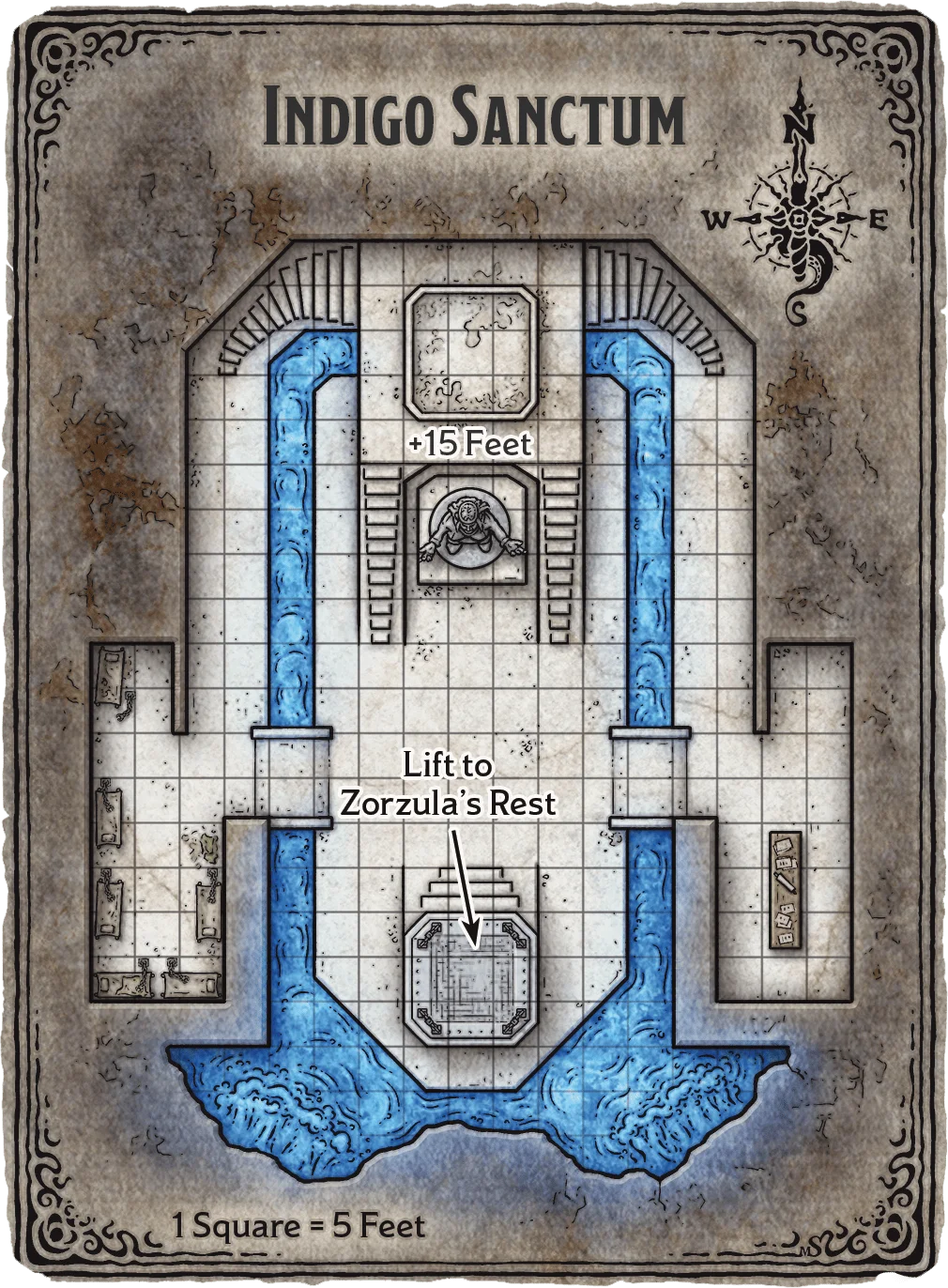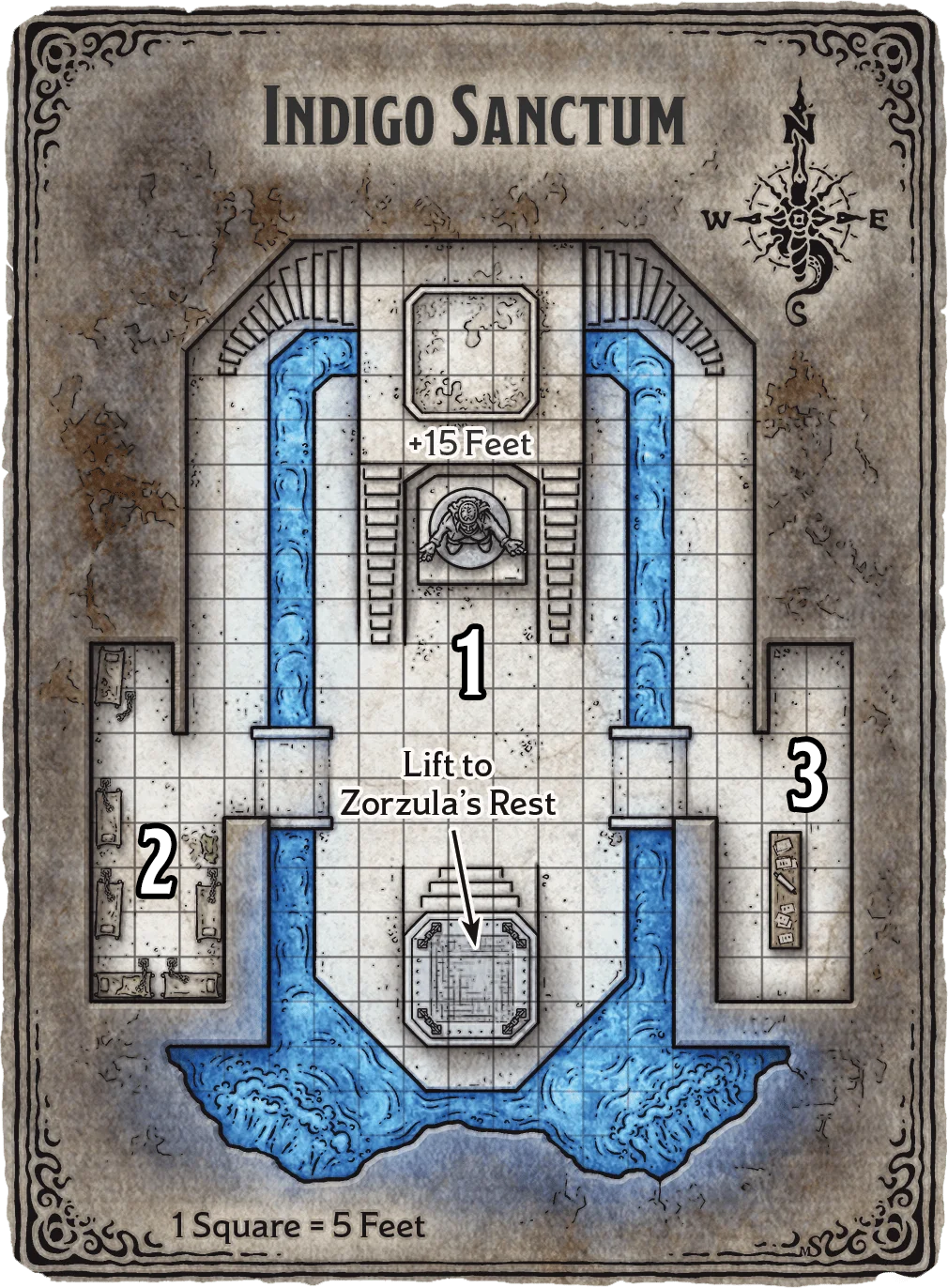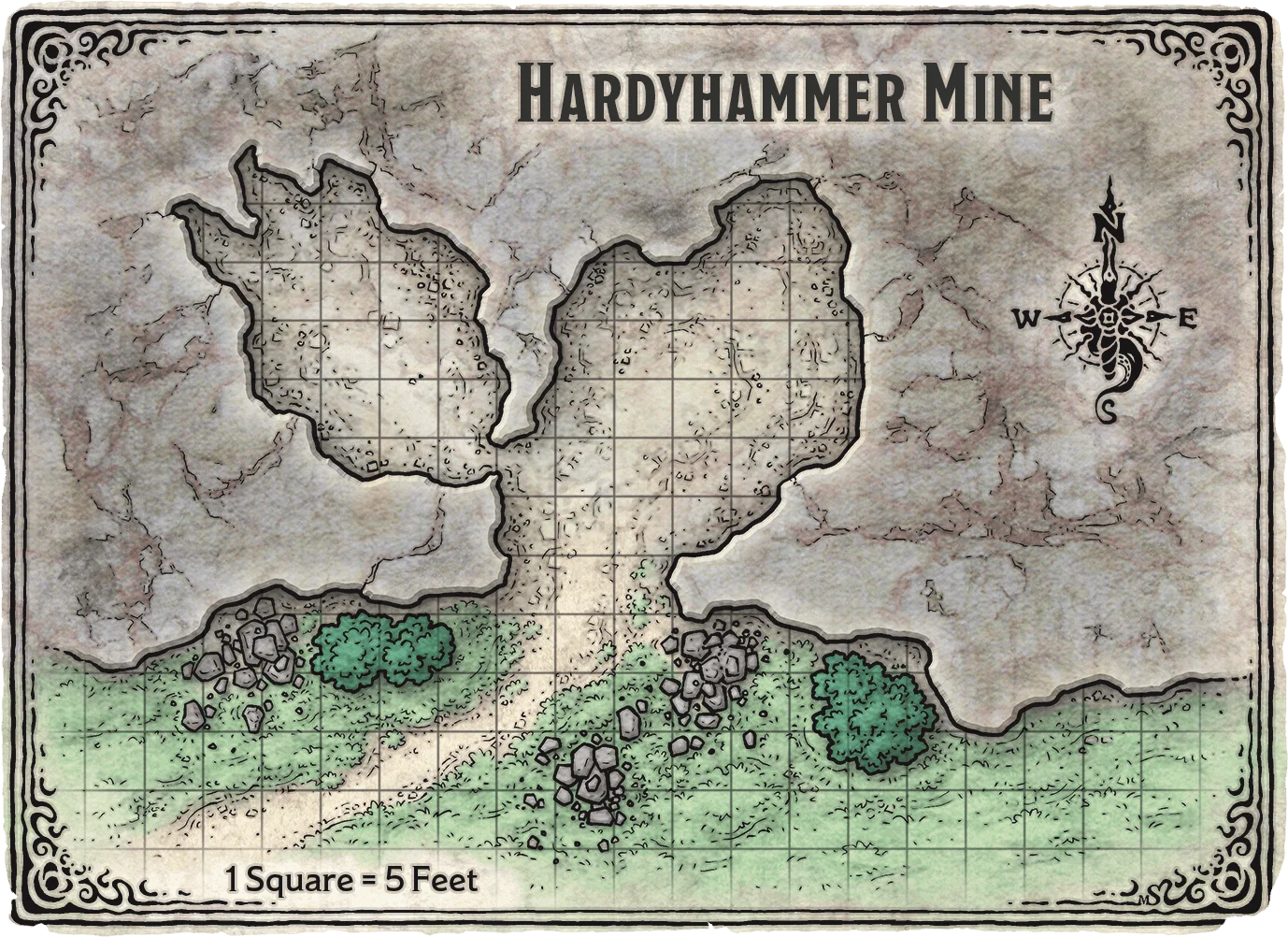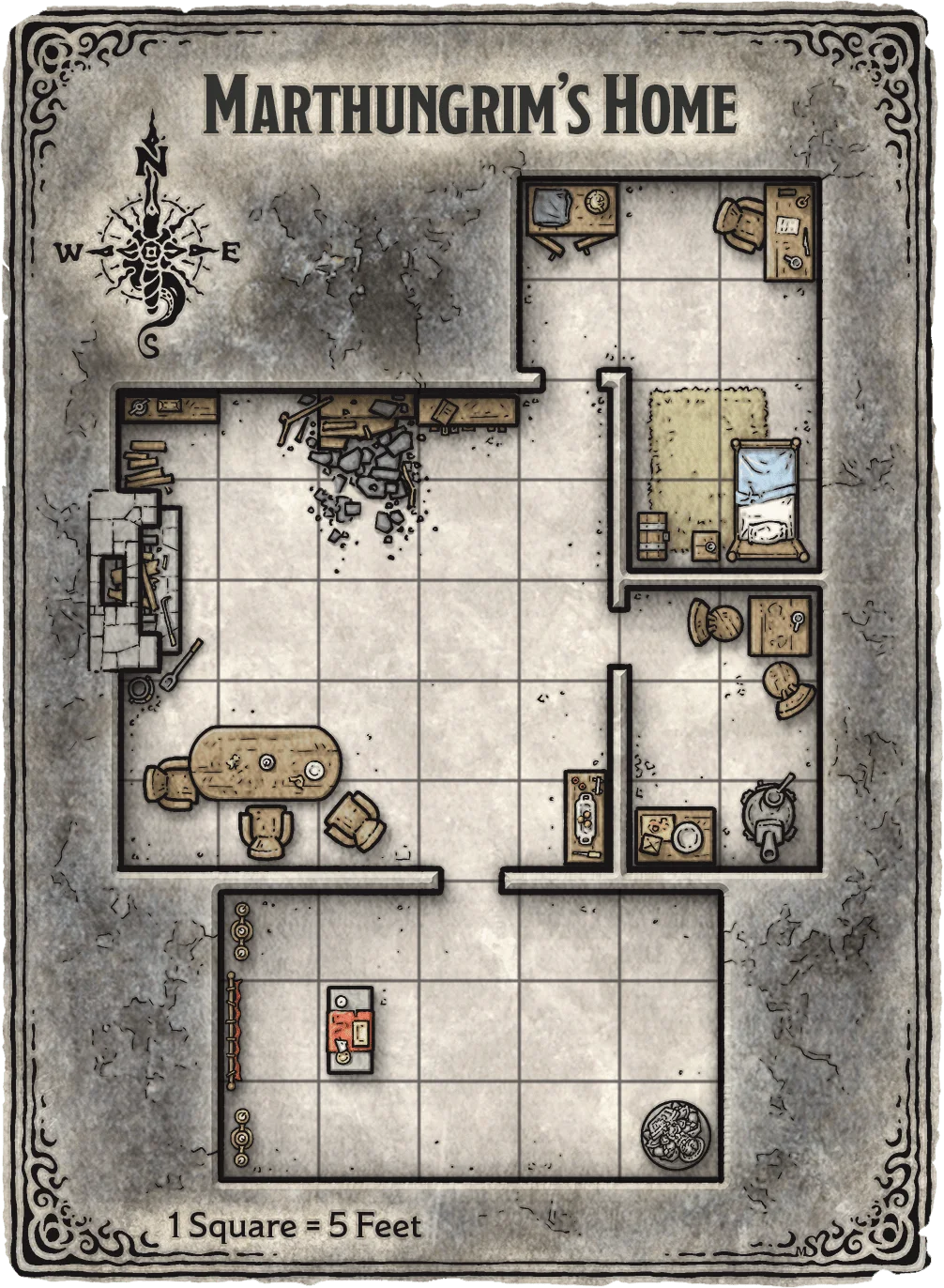In my review of The Shattered Obelisk, I mentioned — among a plethora of other problems — that the book was notable because some of the dungeons and dungeon levels it features aren’t actually keyed. Instead, unnumbered maps of the dungeons are presented, accompanied by a text that describes the various rooms of the dungeon in rambling paragraphs instead of well-organized room keys.
In particular, I pointed out an example from the end of Zorzula’s Rest, where the PCs enter a new level or section of the dungeon called the Indigo Sanctum.
Several people have contacted me to say that I was mistaken. Others have publicly accused me of being a lying liar who lies.
So let’s talk about this a little bit.
People who are wrong on the internet, of course, are a dime a dozen. I don’t have time to respond to everyone who doesn’t know what they’re talking about. But I think this is actually a really important issue — for both adventure designers and Dungeon Masters — and I’d hate to see anyone dismissing it due to a misunderstanding: The fact that D&D no longer teaches DMs how to create and run location-crawls has resulted in a lot of DMs struggling to create and run adventures that should actually be really easy for them. That really sucks for those DMs.
Seeing this atrophying of basic adventure design skills crop up in third-party adventures is also bad. And the fact that we’re now seeing the same failures from Wizards of the Coast’s own designers is really worrisome: If the publishers of D&D lose the institutional knowledge for how to design the most basic adventures, this trend will accelerate and be even more difficult to course correct.
Some people tell me this isn’t a big deal because D&D still makes money. Which… yeah, I can’t even really fathom the logic there.
Some people tell me that this isn’t a big deal because D&D isn’t about dungeons any more. And if that was true, sure. I don’t expect Technoir to teach me how to make dungeons, because that’s not what the game is about. If dungeons aren’t relevant to you, go find the scenario structures that are! But you know who does think D&D is still about dungeons? Wizards of the Coast. The Shattered Obelisk features 25+ dungeons.
Some people tell me that I’m just angry that D&D doesn’t feature “old school dungeons” any more. There’s a lot of false assumptions to unpack there, but I think we can boil it down to a simple reality: If you think “put numbers on a map and write a competent room key” is what defines an “old school dungeon,” then you’re really just proving my point that basic adventure design skills are missing in action.
So if we can all accept that “dungeons don’t exist any more, so it’s okay that this dungeon is bad” is both a paradox and a fallacy, maybe we can take a look at what’s actually going on in The Shattered Obelisk.
THE INDIGO SANCTUM
The Indigo Sanctum, as I mentioned is one of three levels in Zorzula’s Rest. You can see the map of the Indigo Sanctum, as it appears on p. 98 of The Shattered Obelisk, above.
And if we were to properly key this map, it would look like this:
Now, the reason I’m supposedly a lying liar who lies is because this isn’t fair: Those aren’t three separate rooms! The Indigo Sanctum is just one big room!
This, however, is exactly why I chose the Indigo Sanctum as my example from the book. It’s not the only dungeon like this in The Shattered Obelisk, but if I showed you the Hardyhammer Mine:
You might say to me, “Well… c’mon, Justin. That’s only two rooms. Do you really need to key them properly?”
Or maybe I show you Marthungrim’s Home:
Sure, now there are four rooms. “But,” you protest, “only two of them are actually described in the text. So are they even really separate rooms?”
And then maybe we’d argue about what actually counts as a “room.” Or maybe you’d want to debate how large a location needs to be before it counts as a “dungeon.” Just all kinds of delightfully irrelevant semantics.
The thing about Zorzula’s Rest, though, is that none of that matters. You can’t tell me it’s a dungeon that shouldn’t be keyed for some reason, because the rest of the dungeon is keyed.
“Ah, ha!” you say. “But we can still argue about whether those are separate rooms!”
Well, if you want. But it’s not an argument you’ll be having with me. It’s an argument you’ll be having with the book. Because you know who else thinks those are separate rooms?
The designer of the adventure.
The Shattered Obelisk explicitly describes Area 2 and Area 3 on my map above as the “Hostage Room” and the “War Room,” respectively. They’re even given inline headings laden with a bunch of relevant details, meaning that it would have take only the slightest amount of effort to excise them from the middle of the big, rambling description of the dungeon level and properly key them instead.
…
This is the bit where I drop the mic.
DUNGEON HOW-TO
The failure to properly execute the dungeons in The Shattered Obelisk, as I said in the original review and as we’ve seen here, is not just some weird confusion over the final level of Zorzula’s Rest. It is a pervasive problem that occurs multiple times throughout the campaign.
Is it a problem that’s going to persist at Wizards of the Coast? Will this become a trend in future adventures, until perhaps we see official products in which no dungeons are properly keyed?
I hope not.
But it’s possible. We’ve already seen this happen in third-party supplements. It seems impossible; but to a gamer in the mid-‘80s it would have seemed equally unbelievable that hex maps would vanish for a generation… and then they did.
What I actually hope is that the 2024 Dungeon Master’s Guide will be a massive course correction, and we’ll see a full chapter dedicated to teaching new Dungeon Masters how to create and run dungeons. (At this point, I’d even settle for a minor course correction so that the book at least contains an example of a keyed dungeon map.)
Properly keying and running a dungeon is very easy, and that makes it really tempting to dismiss the idea that they’re skills that need to be taught. But the reality is that those are often the most important skills you can teach, because they end up being the foundation on which all the other skills are built.
So let’s keep our fingers crossed that the new Dungeon Master’s Guide is better than the old one; that The Shattered Obelisk is the last time we see Wizards’ designers fail to key their dungeon maps; and that we all get a better foundation on which to build our adventures in the future.
But if not, there’s always So You Want To Be a Game Master.
















Touche…I had hoped that this book would be more than just a reference book like many of the other WoTC books. I am much like you and have played RPGs of all types since the 1980s and as such I cannot think of a time when this would have passed for a proper way to make a dungeon. I even thumbed through many of my old Dungeon magazines to see what passed back then where I found some criteria for publishing that mentioned that what you stated was required to even get your idea published. Yet, here we are roughly 40 years later and the ones who would have at one time enforced those critical requirements are now the ones ignoring their own advice. Keep up the good work, and thanks for telling me where I need to place my hard earned money as a DM who purchases the majority of the books.
I agree, this is like GCSE (9-10th grade stuff).
“Label your drawings!”
In my own designs, I do not necessarily use an 1a thorugh 22z system of labeling, but I do at least name the rooms and have the labels correspond with the text.
Whether or not its better to use names or a key is debatable, on a VTT I feel that naming is superior because you have as much room as you like and you can hide text from the players and only show it to the GM.
But when dealing with physical product, where your map is limited to an A4 page at most, using a key saves space and reduces the impact of revealing rooms to players.
PS. Thanks for saving me $25 on the Shattered Obelisk!
I suppose it’s a function of how many people buy adventures to READ vs. how many buy adventures to PLAY that there’s a trend towards paragraphs of description. When I’m running a game I want to be able to pull out relevant details quickly – break it down into little chunks, give me bullet points and headings, keep it short! It’s baffling to that replaced with long muddled descriptions.
A dungeon without a key is like a highway map without town names. I’d like to think they were going to organize this section but ran out of time. If this is what we can expect from Has-bros & Hobbits, though, it may be time to switch to something else. Or come up with it ourselves.
Rename it “&Dragons”.
In a way, this is one of the aspects of DM culture eroding in D&D: I see it in a lot of places – designing encounters, keying dungeons, playing NPCs, prepping locations, making rulings… the vast majority of DMs seems to believe that these things are self-evident and obvious to figure out, which is why nobody wants to make a guide or basic principles of these things. In fact, because it also fuels the belief that anyone who fails at encounter design, rule calls or dealing with player behavior does so out of malice!
If I “make a ruling”, I still need to understand the resolution mechanics of the game, how often this situation comes up and thread the needle between “so weak that players are disappointed” vs “so strong that now players want to do it all the time”. Worse, you need to keep track of the on-the-spot ruling for consistency, which can proliferate into more and more ruling calls as you altered the foundation of the game.
@Little Fadeleaf: Some of them don’t even think those skills are obvious, they jsut don’t bother even trying. Numerous times I’ve had GMs just literally give up running the dungeon and fast forward us to the boss fight because “that’s the fun part”. Totally deflating. And these unkeyed dungeons probably contribute to them just glossing over the whole thing.
I agree with your criticism of these maps not using keys, the extra clarity and usability has literally no downsides. My only critique here is that the book absolutely comes with keyed dungeons during the Shattered Obelisk section. It’s incorrect to imply the designers forgot what a dungeon key is they literally designed several in the book we’re talking about. New DMs who read this product will still know what a dungeon key is. The non keyed maps depict small spaces that the designers evidently thought didn’t need a key. Some of these spaces would simply not have had a map in older WoTC products, take for instance Wyvern Tor from this adventure compared to the original LMoP. If anything this module spoils for maps and some of these non keyed maps are more like combat maps then anything. Marthungrims home for instance is the exact kind of encounter which would have simply been unmapped in older modules and handled very similarly to old Wyvern Tor. When you criticized unkeyed maps and people disagreed with you, this is probably why.
My perspective is that some of these maps really should have been keyed like Indigo Chamber, while the rest would have simply been a little better if keyed. The most important maps were keyed however and that’s why I categorize this more as a nitpick. There are other more profound problems with the book.
At a quick glance, the module seemed alright. I admit, got a little ahead of myself and made a rash decision to get the book before checking out PDF and reviews. I have been running a highly modified version of LMoP and DoIP together with a major Far Realms twist so only seemed right that Phandelver and Below would be a good continuation, unfortunately it wasn’t even a fraction of what I had hoped for but should of expected. Anyway, curious if you will be doing a remix of some kind on the adventure, while some elements are a complete waste of time, I think there is enough here that can be saved and with some effort, turned into an adventure that can truly be great. So, any chance we can get a remix of it by you?
Interesting read. Only just discovered your site (and book, which I pre-ordered).
As to what qualifies as a room: I often visit cathedrals, minsters, and abbeys. There are often chapels and other areas that are really just large areas off the main cathedral. They can be separated by a wall, a railing, or nothing at all. A DM wouldn’t want to read a description of entirety of very possible area that can be viewed (or not, depending on how the cathedral is laid out). That’s too much information being read out loud to properly process.
Just looking at our modern layout of the “open plan home,” it’s common to have the dining area be part of the living room and also be open to the kitchen at the same time with only a counter partially dividing the space. A big open space can often be segregated by purpose rather than a wall. How would a cave be any different?
Key the room in a broad, brief description, but also key important areas individually. It’s important, and possible, to create content for a broad range of skill levels without assuming too much, nor aiming at the lowest common denominator.
Dear Justin, I feel bad for just discovering your book. I have made extensive use of your Descent into Avernus Remix, and my players had a grand time in the Avernus. One experienced player, who had been in the same campaign before at another table, told me he enjoyed the way I ran it so much more. I attribute more than half of that to you having done such a tremendous work in your Remix.
Of course, now that I’ve just discovered your book, I didn’t hesitate to put it an order. I’m excited to devour it and to bookmark it for all the important easy to find details.
My finals straw with WOTC was Avernus. I have never used as many bookmarks in an adventure book as I did with that adventure. Good gods, they really didn’t do a good job with even the most basic of cataloging. Important information is scattered everywhere across.
This post touches on a very important concern of mine. The degradation of third party content due to Wizards’ continued lowered standards.
Is it possible that we in the near future could get a curated list of 3rd party adventures and modules recommended by you? As someone who has made use of the DMs guild, it would be greatly appreciated 🙏🏼
Thank you for all your hard work!